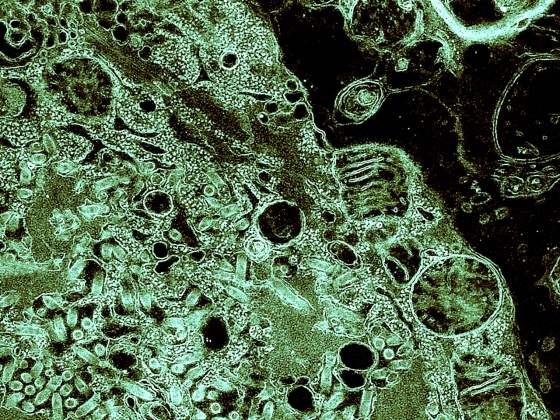Rabies killed a patient who got a kidney transplant more than a year ago, federal officials said Friday. Now they are treating three other people who got a second kidney, a heart and a liver from the same donor – an Air Force recruit who apparently died of undiagonosed rabies.
The donor died in Florida, and the heart, kidneys and liver from the patient were transplanted into three other people, the Centers for Disease Control and Prevention said. The Defense Department said the donor was a 20-year-old recruit who had been in the Air Force for just under four months when he died in 2011.
Doctors did not suspect rabies killed the donor and did not test for the virus, the CDC said. "Rabies was only recently confirmed as the cause of death after the current investigation began in Maryland," the CDC said.
"Shortly before becoming ill, the donor had moved to Florida, but was a previous resident of North Carolina where it is believed the exposure may have occurred. How the donor may have gotten rabies is currently under investigation," the CDC said in a statement.
The agency is not naming any of the patients involved.
"In 2011, the donor became ill and was admitted to a healthcare facility in Florida and then died. At that time, the donor’s organs, including the kidneys, heart, and liver, were recovered and sent to recipients in Florida, Georgia, Illinois, and Maryland," the CDC said.
Potential organ donors in the United States are screened and tested for viruses, bacteria and other infections. But rabies isn't one of the usual microbes that is tested for, in part because the test takes too long and in part because rabies is so rare in people.
People can become infected with rabies without knowing it. It is transmitted in saliva -- which is why animal bites are dangerous -- and blood. But vaccination after a bite can prevent symptoms. Once a patient develops symptoms from rabies, it is almost always fatal.
Bats are the most common cause of rabies infection, while raccoons, skunks, and foxes are the most commonly reported rabid animals.
"CDC’s preliminary laboratory analysis indicates that the recipient and the donor both had the same type of rabies virus—a raccoon type. This type of rabies virus can infect not only raccoons, but also other wild and domestic animals. In the United States, only one other person is reported to have died from a raccoon-type rabies virus,' the CDC said. Genetic testing can reveal what strain of virus has infected someone and advanced testing that looks for genetic mutationscan show whether someone was directly infected by someone else.
"The three other people who received organs from the donor have been identified and are currently being evaluated by their healthcare teams and receiving rabies anti-rabies shots (immune globulin and anti-rabies vaccination)," the CDC said.
"CDC is working with public health officials and healthcare facilities in five states (Fla., Ga., Ill., Md., and N.C.) to identify people who were in close contact with the initial donor or the four organ recipients and might need rabies post-exposure treatment," the agency says.
Doctors perform 40,000 organ transplants annually worldwide. In 2011, a team at Northwestern University’s school of medicine estimated that fewer than 1 percent of all organ transplants also transmitted an infection.
More than 28,000 organ transplants are performed in the U.S. each year, while more than 114,000 people are waiting for organ transplants, according to the United Organ Sharing Network. In 2011, 6,669 people died waiting for organ transplants.
Organ donors are routinely tested for hepatitis viruses, HIV, a virus called HTLV that can cause leukemia, the syphilis bacteria, West Nile virus and the parasite that causes Chagas disease. But other infections have been transmitted by organ, tissue and other transplants – including the deadly brain disease called Creutzfeldt Jakob disease or CJD; herpes, cytomegalovirus and a variety of bacterial and fungal infections.
Rabies is also known to have been transmitted both by cornea transplants and organ transplants – most recently a batch of three organ recipients treated at Baylor University in Texas in 2004. Officials ended up treating hundreds of people who had been in contact with the organ donor and the recipients.
But last August, Melissa Greenwald, chief of the Tissue and Reproduction Branch at the Food and Drug Administration raised concerns about the lack of a systematic protocol for testing organs and tissue used for transplant.
“Disease transmission through organ and tissue transplantation has been documented. Recognizing emerging infectious diseases in organ and tissue transplantation is challenging because of nonstandardization of donor evaluations and data collection, pathogen characteristics, and recipient surveillance,” Greenwald and colleagues wrote in Emerging Infectious Diseases.
“Because organs, cells, and some tissue grafts cannot be subjected to sterilization steps, the risk of infectious disease transmission remains and thorough donor screening and testing is especially important.”
Organ recipients are especially vulnerable because they’ve usually been ill for along time, and then must take drugs to suppress their immune systems so their bodies will tolerate the donated organ.
Related:
